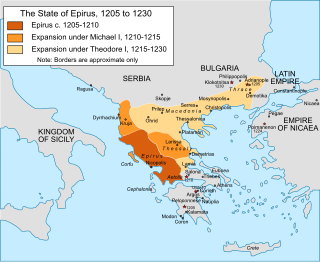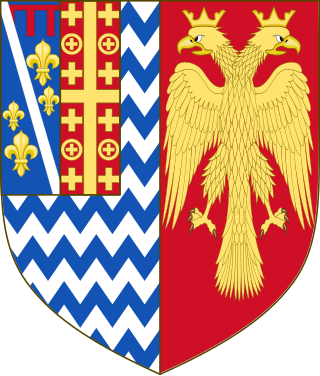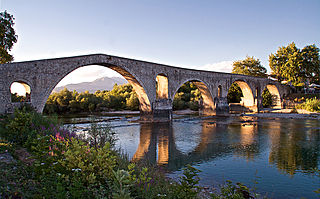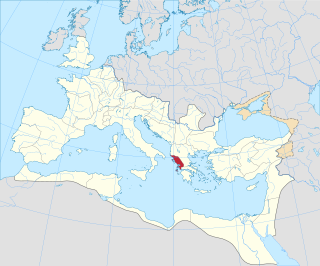
The Despotate of Epirus was one of the Greek successor states of the Byzantine Empire established in the aftermath of the Fourth Crusade in 1204 by a branch of the Angelos dynasty. It claimed to be the legitimate successor of the Byzantine Empire during the subsequent struggle for Constantinople, along with the Empire of Nicaea and the Empire of Trebizond; its rulers briefly proclaiming themselves as Emperors in 1227–1242. The term "Despotate of Epirus" is, like "Byzantine Empire" itself, a modern historiographic convention and not a name in use at the time.

The despot of Epirus was the ruler of the Despotate of Epirus, one of the successor states of the Byzantine Empire in the aftermath of the Fourth Crusade. The name "Despotate of Epirus" and the title "despot of Epirus" are modern historiographical names, and were not in use by the despots themselves. In the Byzantine Empire, the title of despot was a prestigious court title and did not designate rule over some specific territory. Though several of the early Greek rulers of the Epirote realm did use the title of despot, it was never in reference to the lands they governed, but instead in reference to their position in the imperial hierarchy.

Pogoniani is a village and a former community in the Ioannina regional unit, Epirus, Greece. Since the 2011 local government reform it is part of the municipality Pogoni, of which it is a municipal unit. The municipal unit has an area of 56.693 km2, the community 18.830 km2. The municipal unit consists of 4 villages: Pogoniani, Dolo, Drymades, Stavroskiadi.

Arta is a city in northwestern Greece and capital of the regional unit of Arta, which is part of Epirus region. The city was known in ancient times as Ambracia. Arta is known for the medieval bridge over the Arachthos River, as well as for its ancient sites from the era of Pyrrhus of Epirus and its well-preserved 13th-century castle. Arta's Byzantine history is reflected in its many Byzantine churches; perhaps the best known is the Panagia Paregoretissa, built about 1290 by Despot Nikephoros I Komnenos Doukas.

The County Palatine of Cephalonia and Zakynthos existed from 1185 to 1479 as part of the Kingdom of Sicily. The title and the right to rule the Ionian islands of Cephalonia and Zakynthos was originally given to Margaritus of Brindisi for his services to William II, King of Sicily, in 1185.
Euroea or Euroia was a city in Epirus, in western Greece, during late antiquity. It was abandoned in the early 7th century due to Slavic invasions. During the 4th–8th centuries, it was a bishopric. Since the 18th century, it has also been a titular see of the Catholic Church. Its site is located near the modern village of Glyki in Greece.

Borsh Castle also known as Sopot Castle from the hill it is located, is a ruined castle near the village Borsh, Albania, near the coast of the Ionian Sea. Inside the castle is the 17th-century Hajji Bendo Mosque from Ottoman times.

The Theme of Nicopolis or Nikopolis was the name of a Byzantine theme located in northwestern Greece, encompassing Aetolia-Acarnania and southern Epirus. It was established in the second half of the 9th century, probably after 886, and survived until the dissolution of the Byzantine Empire by the Fourth Crusade in 1204.
Vagenetia or Vagenitia was a medieval region on the coast of Epirus, roughly corresponding to modern Thesprotia. The region likely derived its name from the Slavic tribe of the Baiounitai. It is first attested as a sclavinia under some sort of Byzantine control in the 8th/9th centuries. It passed under Bulgarian rule in the late 9th century, and returned to Byzantine rule in the 11th. It passed to the Despotate of Epirus after 1204, where it formed a separate province. Vagenetia came under Albanian rule in the 1360s, until conquered by the Ottoman Empire in 1430.

Rogoi is a Byzantine castle in Nea Kerasounta near Preveza, in western Greece. It is located on the site of the ancient city of Bouchetion (Βουχέτιον), which was abandoned in the late 1st century BC. Re-occupied in the 9th century, it became a bishopric and was refortified, playing an important role in the region's history in the 14th and early 15th centuries. It was abandoned again after the Ottoman conquest in 1449.

Kolonjë is a municipality in Korçë County, southeastern Albania. It was created in 2015 by the merger of the former municipalities Barmash, Çlirim, Ersekë, Leskovik, Mollas, Novoselë, Qendër Ersekë and Qendër Leskovik. The seat of the municipality is the town Ersekë. The total population is 11,070, in a total area of 865 km2 (334 sq mi). It is an ethnographic region.
Photice or Photike was a city in Epirus in the Roman and Byzantine periods. In the late Middle Ages it was known as Hagios Donatos.
Bela or Vela was a medieval fortress town and bishopric in Epirus, northwestern Greece.

The Metropolis of Ioannina is a Greek Orthodox diocese centred on the city of Ioannina, in the Epirus of Greece. As one of the "New Lands", it belongs formally to the Patriarchate of Constantinople, but is administered by the Church of Greece. As of June 2014, the Metropolitan of Ioannina is Maximos Papagiannis.

The province of Epirus was a province of the Roman Empire, covering the region of Ancient Epirus. Rome first annexed the region in 167 BC, in the aftermath of the Third Macedonian War, and initially put the region in the larger Roman province of Macedonia, which at the time covered the whole of the Hellenistic world in mainland Europe. In 27 BC, Epirus and Achaea were separated from Macedonia and grouped into the senatorial province of Achaea, with the exception of its northernmost part, which remained part of the province of Macedonia. Under Emperor Trajan, sometime between 103 and 114 AD, Epirus became a separate province, under a procurator Augusti. The new province extended from the Gulf of Aulon (Vlorë) and the Acroceraunian Mountains in the north to the lower course of the Acheloos River in the south, and included the northern Ionian Islands of Corfu, Lefkada, Ithaca, Cephallonia, and Zakynthos.

The Panagia Olympiotissa Monastery is a Greek Orthodox monastery in Elassona, Thessaly, Greece.
The Diocese of Bela is a Roman Catholic titular diocese in Greece.
Glyki or Glyky (Γλυκύ) is a village in Thesprotia, in northwestern Greece.
Riniasa Castle, originally known as Thomokastron, is a medieval Byzantine fortress on the coast of Epirus, close to the modern village of Riza near Preveza. The castle is today in a ruinous condition.

The Castle of Arta is a medieval fortification in the city of Arta in western Greece.
















